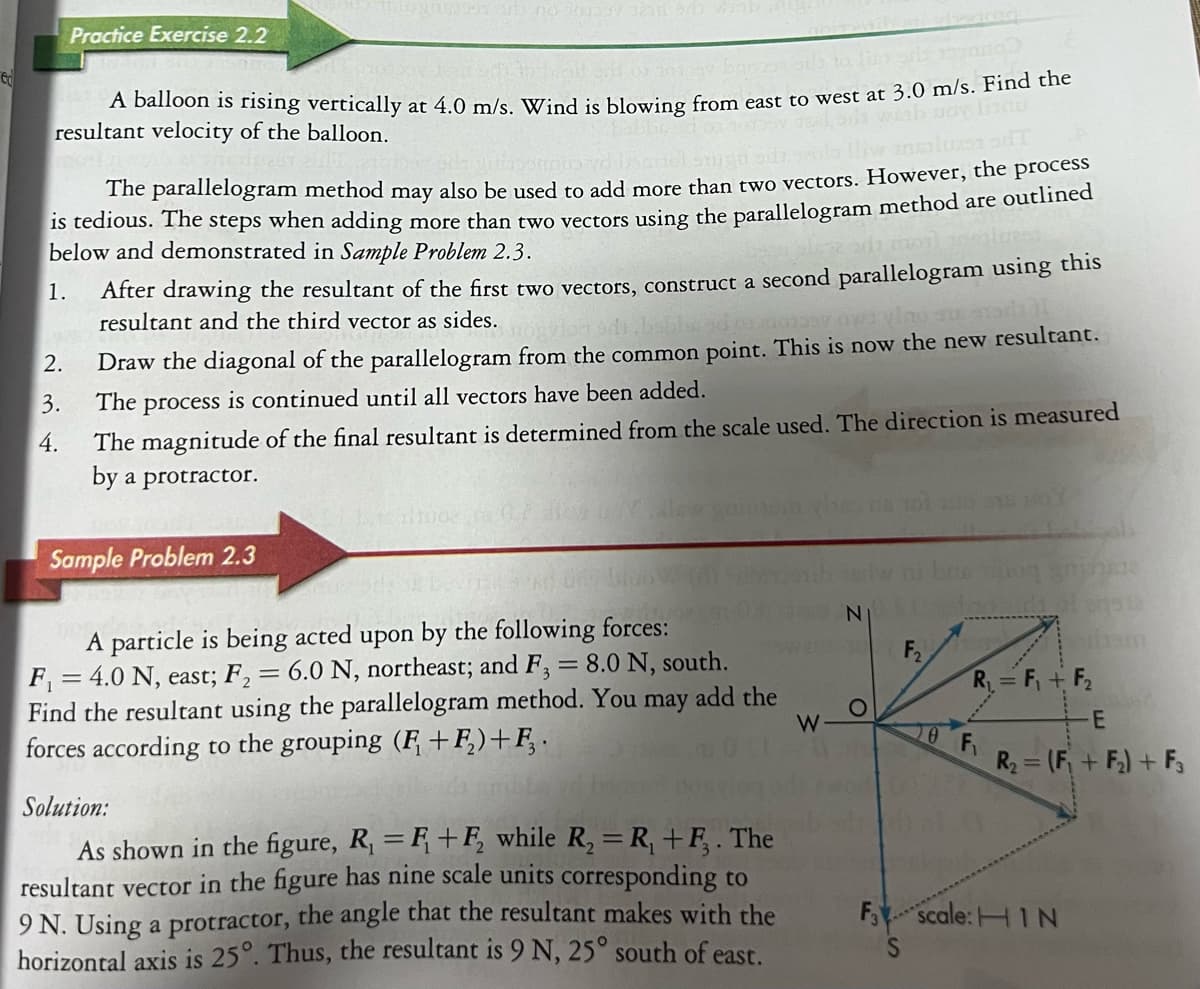Practice Exercise 2.2 A balloon is rising vertically at 4.0 m/s. Wind is blowing from east to west at 3.0 m/s. Find the resultant velocity of the balloon. wab soy liau The parallelogram method may also be used to add more than two vectors. However, the process is tedious. The steps when adding more than two vectors using the parallelogram method are outlined below and demonstrated in Sample Problem 2.3. 1. After drawing the resultant of the first two vectors, construct a second parallelogram using this resultant and the third vector as sides. 0233y ows vino summaris 11 Draw the diagonal of the parallelogram from the common point. This is now the new resultant. The process is continued until all vectors have been added. 2. 3. 4. The magnitude of the final resultant is determined from the scale used. The direction is measured by a protractor.
Practice Exercise 2.2 A balloon is rising vertically at 4.0 m/s. Wind is blowing from east to west at 3.0 m/s. Find the resultant velocity of the balloon. wab soy liau The parallelogram method may also be used to add more than two vectors. However, the process is tedious. The steps when adding more than two vectors using the parallelogram method are outlined below and demonstrated in Sample Problem 2.3. 1. After drawing the resultant of the first two vectors, construct a second parallelogram using this resultant and the third vector as sides. 0233y ows vino summaris 11 Draw the diagonal of the parallelogram from the common point. This is now the new resultant. The process is continued until all vectors have been added. 2. 3. 4. The magnitude of the final resultant is determined from the scale used. The direction is measured by a protractor.
Physics for Scientists and Engineers, Technology Update (No access codes included)
9th Edition
ISBN:9781305116399
Author:Raymond A. Serway, John W. Jewett
Publisher:Raymond A. Serway, John W. Jewett
Chapter11: Angular Momentum
Section: Chapter Questions
Problem 11.4OQ: Let the four compass directions north, east, south, and west be represented by unit vectors ne . ....
Related questions
Question
Answer practice 2.2. 1,2,3,4 questions based it from sample 2.3 Thanksss!!

Transcribed Image Text:ed
Practice Exercise 2.2
A balloon is rising vertically at 4.0 m/s. Wind is blowing from east to west at 3.0 m/s. Find the
resultant velocity of the balloon.
2.
3.
4.
nor or no 305 37 327 947
The parallelogram method may also be used to add more than two vectors. However, the process
is tedious. The steps when adding more than two vectors using the parallelogram method are outlined
below and demonstrated in Sample Problem 2.3.
1.
After drawing the resultant of the first two vectors, construct a second parallelogram using this
resultant and the third vector as sides.
di babbed a messy
Draw the diagonal of the parallelogram from the common point. This is now the new resultant.
The process is continued until all vectors have been added.
The magnitude of the final resultant is determined from the scale used. The direction is measured
by a protractor.
Sample Problem 2.3
A particle is being acted upon by the following forces:
F₁ = 4.0 N, east; F₂ = 6.0 N, northeast; and F3 = 8.0 N, south.
Find the resultant using the parallelogram method. You
forces according to the grouping (F+F₂) + F₂.
may add the
Solution:
As shown in the figure, R₁ = F₁+F₂ while R₂ = R₁ +F₂. The
resultant vector in the figure has nine scale units corresponding to
9 N. Using a protractor, the angle that the resultant makes with the
horizontal axis is 25°. Thus, the resultant is 9 N, 25° south of east.
W-
118 101 3110 31
O
F₂
R₁ = F₁+F₂
20 F₁
busin
-E
R₂= (F₁+F₂) + F3
F₁ scale: H1N
Expert Solution
This question has been solved!
Explore an expertly crafted, step-by-step solution for a thorough understanding of key concepts.
Step by step
Solved in 2 steps with 1 images

Knowledge Booster
Learn more about
Need a deep-dive on the concept behind this application? Look no further. Learn more about this topic, physics and related others by exploring similar questions and additional content below.Recommended textbooks for you

Physics for Scientists and Engineers, Technology …
Physics
ISBN:
9781305116399
Author:
Raymond A. Serway, John W. Jewett
Publisher:
Cengage Learning

Glencoe Physics: Principles and Problems, Student…
Physics
ISBN:
9780078807213
Author:
Paul W. Zitzewitz
Publisher:
Glencoe/McGraw-Hill

Physics for Scientists and Engineers, Technology …
Physics
ISBN:
9781305116399
Author:
Raymond A. Serway, John W. Jewett
Publisher:
Cengage Learning

Glencoe Physics: Principles and Problems, Student…
Physics
ISBN:
9780078807213
Author:
Paul W. Zitzewitz
Publisher:
Glencoe/McGraw-Hill